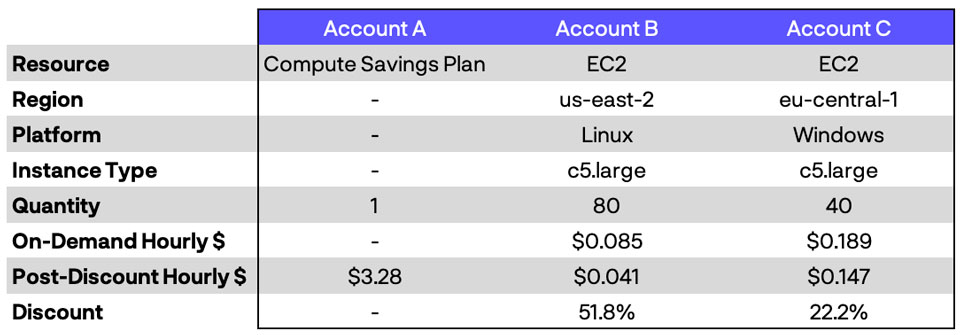The cloud is expensive and companies are constantly looking for ways to reduce their cloud bill. That’s why a few years ago we started ProsperOps and launched our first product—Autonomous Discount Management. Customers configure a few settings, turn our service on, and algorithms take over management of discount instruments to maximize cloud savings. We are now doing this on more than half a billion dollars of annual compute spend for some of the world’s leading brands, and delivering industry leading results.
That’s great for a customer’s overall bottom line, but businesses also need a way to allocate costs back internally. If we generate incremental savings, but customers can’t properly apply the benefits to their stakeholders, the value is diminished.
That’s why we are excited to announce ProsperOps Intelligent Showback. This new capability takes the pool of savings our Autonomous Discount Management service has maximized at the company level, and provides multiple methods for reallocating savings across the organization.
Current Showback Flaws
Showback is the process companies use to take a single, centralized cost and internally allocate it back to departments, teams, products, etc. based on their proportional consumption. Showback is complex and incredibly hard to get right. This is particularly true when discount instruments like Reserved Instances (RIs) and Savings Plans (SPs) are involved and it stems from two ways the AWS billing system was implemented:
Wouldn’t it be nice to maximize overall company savings AND be able to control how that pool of savings is split? That is why we built Intelligent Showback. 😃
There are existing third-party tools today that address the first problem above. They show commitment costs where they applied versus where they were purchased. That is helpful and better than native AWS billing views, but you are still a prisoner to where AWS chooses to apply the discounts. What makes Intelligent Showback unique is that it solves both issues.
Intelligent Showback vs. The Alternatives
Intelligent Showback takes the pool of savings optimized by ProsperOps at the organization level and provides multiple methods to accurately allocate those savings to stakeholders.
To help illustrate the existing showback problem and how Intelligent Showback compares, consider the following simple example of an AWS organization with three accounts:
Account A is owned by the centralized FinOps team for purchasing AWS Reserved Instances and/or Savings Plans. It contains a single 3 Year No Upfront Compute Savings Plan of $3.28/hr and no compute usage.
Account B is owned by Business Unit 1 and runs 80 c5.large instances of Linux in us-east-2.
Account C is owned by Business Unit 2 and runs 40 c5.large instances of Windows in eu-central-1.

In this example, let’s play out what happens over a 100 hour period. AWS controls the application of the Compute Savings Plan which floats to cover 100% of the c5.large instances in Account B (because they have the higher discount) and no c5.large instances in Account C, as shown here:

Native AWS Billing
Native AWS billing (which includes related tools like Cost Explorer) shows cost and savings allocation across teams as follows:

- The Central FinOps team accrues $328 of cost from the Compute Saving Plan. They bear the full cost burden for the company while other teams receive the savings benefit.
- Business Unit 1 has no cost! Their on-demand usage was completely offset by the central Compute Saving Plan (that the Central FinOps team paid for) so their savings is $680 and their effective discount is 100%.
- Business Unit 2 pays full on-demand pricing of $756 and receives zero savings!
If the Business Unit 2 leader truly understands the data, they should push back on the effectiveness of this showback method. Ultimately, if the use of the method persists, they should reject centralized FinOps and purchase their own commitments (hence, the AWS setting to disable RI and SP sharing) which would hurt overall company savings.
Traditional Showback
Traditional Showback addresses the centralization of commit discount costs only, so cost and savings allocation across teams looks as follows:

- The Central FinOps team now has no cost (which is an improvement) since this model allocates costs where AWS happened to apply the discount.
- Business Unit 1 now has the cost of the Compute Savings Plan allocated to them for which they received the savings benefit. Their costs increase to $328 so their savings is decreased to $352, which is an effective discount of 51.8% (the max discount when usage of this type is 100% covered).
- Nothing changes here. Business Unit 2 still pays full on-demand pricing and receives zero savings benefit.
While this is an improvement over native AWS billing showback, the Business Unit 2 leader should still reject this because they are receiving no benefit from a centralized FinOps model. This doesn’t solve the showback problem.
Intelligent Showback
Intelligent Showback decouples savings allocation from how the AWS blackbox chooses to apply discounts. In this model, the cost and savings allocation across teams looks as follows:

- The Central FinOps team has no cost because they had no usage that received a savings benefit.
- Business Unit 1 and Business Unit 2 each receive a proportional share of the overall savings generated relative to 1) the amount of their usage, and 2) the discount rates of their usage.
- Business Unit 1’s cost is higher at $442 because they no longer receive all of the discount benefit. Their savings is $238, which is an effective discount of 35.0%.
- Business Unit 2’s cost is lower at $642 because they now (finally) get a portion of the savings. Their savings is $114, which is an effective discount of 15.0%.
- Note Business Unit 1’s effective discount of 35.0% is higher then Business Unit 2’s of 15.0% because Business Unit 1 runs Linux EC2 in us-east-2 (with a max effective discount of 51.8% @ 100% coverage) vs. Business Unit 2 which runs Windows EC2 in eu-central-1 (with a max effective discount of 22.2% @ 100% coverage).
Note: Intelligent Showback is designed to have modular savings reallocation methods. This example uses the Shared Benefit method but other methods, which provide different savings allocation benefits, are in development.
With Intelligent Showback, companies can finally control how cloud savings are allocated. This enables a more reasonable and sustainable showback of costs, a mature, centralized FinOps capability, and puts companies on the path to determining accurate unit costs.
When combined with Autonomous Discount Management, ProsperOps now offers companies a single, simple solution to both generate industry leading savings outcomes AND control allocation of those savings to effectively showback costs. We hope these capabilities help you to prosper in the cloud!
Visit our help center for more information on Intelligent Showback, or schedule a demo of our cloud financial management platform to get a closer look.
Prosper On!




